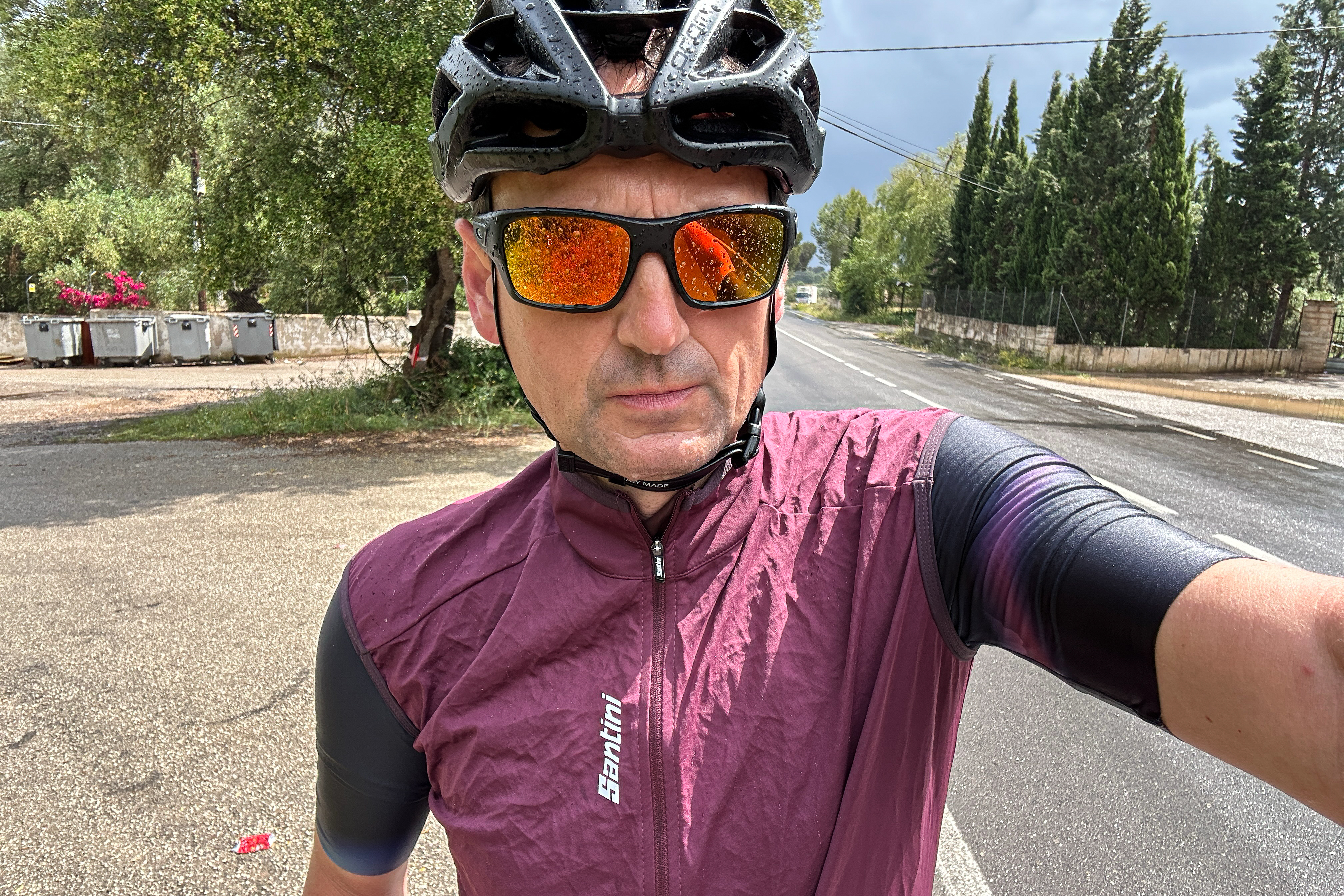As I write this, the Tour de France is in full swing, with Santini branding prominent on the leader’s jerseys and roadside adverts, so it is very timely that I have been riding in one of their new outer layers for the last few months.
After padded shorts and a 3-pocket jersey, a cycling gilet is probably the third most useful item of clothing for riding a bike, but is a waterproof one really necessary or useful?
While at first it might not appear to be a great concept, having been a convert to waterproof shorts for mountain biking after initial scepticism, I was ready to try Santini’s Magic packable Waterproof Vest Unisex with an open mind.
Construction
As brands scramble to produce viable alternatives to waterproof fabrics that use harmful PFAS (polyfluorinated alkyl substances), various alternative technologies have been embraced. Santini has chosen to use Polartec’s Power Shield RPM (recycled polyester membrane) in the Magic Vest (and jacket).
This is an interesting-sounding fabric with stats that point to the priorities behind the Magic Packable Waterproof Vest with Powershield RPM offering 10,000mm of hydrostatic head and 30,000 g/m²/24hrs of moisture vapour transmission.
For those of you who don’t speak fluent geek, hydrostatic head measures the height of the water column in mm required to penetrate the fabric and moisture vapour transmission (breathability) is measured as grams of vapour that can pass through a square metre of fabric in a day.
The Polartec Power Shield RPM is soft and matte with a shiner membrane on the inside
(Image credit: Andy Jones)
The important thing to take away from these figures is that 10,000mm of hydrostatic head is not particularly good (although it is sufficient to call itself waterproof), but 30,000 g/m²/24hrs is excellent, especially for a membraned fabric. So clearly Santini and Polartec have concentrated on breathability rather than waterproofness, which makes perfect sense for a performance cycling piece, as generated moisture (sweat) can be much more of a problem on a bike than external rain. As if to underline this, the seams aren’t taped and the double-ended zip isn’t a waterproof one.
The DWR-coated Power Shield RPM has a nice, soft hand with a matte outer fabric that doesn’t have any of the typical ‘crisp packet’ feel to it. In fact, the material is quite stretchy and more like a woven softshell than a waterproof. The inside of the vest is smooth and shiny, as this is where the actual waterproof membrane resides, and Santini claims that, unlike most waterproof membranes, the Power Shield RPM doesn’t suffer from a drop in performance as the material wets out or gets dirty.

Hip pocket acts as a stuff sack for the vest
(Image credit: Andy Jones)
Elsewhere, there is a nice high collar with an elasticated top, elasticated arm holes and an elasticated hem – all very simple but neatly done. A Santini-branded loop on the collar provides a way to hang it up, and there is a small, vertical zipped pocket on the left hip that doubles as a stuff sack for the vest when not in use. The Santini Cycling branding on the back is reflective.
I weighed my size large gilet in at 111g, and it is available in four colours and eight sizes.
Santini also makes a Magic long-sleeved jacket using the same fabric and design if you like the sound of the Magic Vest but would prefer some arm protection.
The ride
After a morning of checking the weather apps, I was sure I’d spotted a two-hour window in the Mallorcan rain, so I got changed and set off with the Magic vest in my pocket just in case. After less than 500 metres, the heavens opened and I found myself in the first of three absolutely biblical downpours that the Met Office had failed to spot.
Now, I am not for a moment going to pretend that the Magic Vest kept me dry. With running water rim deep on the roads and passing cars sending heavy waves over me every few seconds, little short of a submarine would have provided sufficient protection, but I was surprisingly comfortable. So much so that, once already soaked to the skin, I extended my ride and didn’t scurry off home as fast as I could.

(Image credit: Tim Russon)
In part, this was because it was still 20°C / 68°F despite the rain, but also because the Magic Vest did a great job of keeping my core warm, much more so than a lighter-weight windproof garment would have done. Furthermore, in those particular circumstances, I think that the vest kept me more comfortable than a clammy full waterproof jacket would have done, too.
The soft outer fabric looked and felt great, with plenty of stretch for ease of movement, and although I think that a medium would have fitted me fine over a summer jersey, it seemed prudent to choose a size large for potential winter duties. In fact, I can see the Magic Vest being very handy for winter riding worn over something like the Castelli Espresso Air Jacket that can cope with showers, but not real rain. It is lighter and less restrictive than most long-sleeved waterproofs and more packable as well.

The Magic Vest proved itself comfortable and breathable
(Image credit: Andy Jones)
In terms of its unisex billing, I’d imagine that the stretch and relaxed fit would allow it to work for a wide variety of body shapes.
The Magic Vest was also pressed into service in less extreme conditions than I experienced in Mallorca, and it proved itself to be more breathable than I had imagined; less so than Castelli’s excellent Espresso Vest, but far more wind and water-resistant than that piece. It was also warmer than most gilets, not least because the Magic Vest doesn’t have any mesh panels, so it provides great protection whatever direction the wind is coming from.
Value and conclusion
The Santini Magic Packable Waterproof Vest’s biggest issue is that it is such an unusual concept. Most riders will understandably choose a long-sleeved jacket instead for waterproof duties and a lighter/cheaper gilet for wind protection.
In truth, the Magic vest doesn’t replace either of these products, but it is ideal for certain rather niche applications – warm, wet rides or as an additional barrier over a shower-resistant winter jacket. As a UK cyclist, its £120 asking price is tough. Not because it isn’t worth it; the fabric, breathability and comfort are very good, but just because the number of times it would be the perfect garment is limited. It’s a gilet that you can certainly live without, but one which you would use and come to appreciate if you make the leap of faith and add it to your cycling wardrobe.
My 4 star rating doesn’t reflect any issues with the product, merely its narrow operating window and large overlap with other garments likely to be in your possession already.
